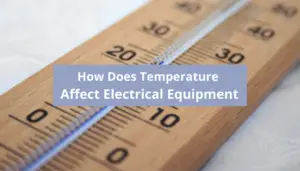Introduction
Electrical systems are an integral part of modern society, and their efficiency and reliability are essential for safe and successful operations.
Voltage drop is an important aspect of electrical systems that is often overlooked but can have significant implications on the performance of the system.
In this article, we will explore the effect of wire size on voltage drop in electrical systems, its causes, and solutions to minimize voltage drop.
Table of Contents
What is voltage drop?
Voltage drop is the reduction in voltage that occurs when electrical current flows through a wire or conductor due to the resistance of the wire.
This reduction in voltage can cause problems in electrical systems, such as a decrease in the performance of appliances, damage to electrical equipment, and even electrical fires.
What causes voltage drop?
Voltage drop is caused by the resistance of the wire, which is dependent on the wire’s size, length, and the material it is made of.
The longer the wire, the higher the resistance, and the larger the wire’s size, the lower the resistance. This resistance causes energy to be lost as heat, which reduces the voltage of the electrical current.
Effect of wire size on voltage drop
The size of the wire is a crucial factor that determines the amount of voltage drop in an electrical system.
The larger the wire’s size, the lower the resistance, which means less energy is lost as heat, resulting in less voltage drop. Therefore, using larger wire sizes can significantly reduce the voltage drop in electrical systems.
For instance, a 12-gauge wire has less resistance than a 14-gauge wire, which means it experiences less voltage drop over a given length. In contrast, a 16-gauge wire has higher resistance, resulting in more voltage drop over the same distance.
Solutions to minimize voltage drop
Using larger wire sizes is one solution to minimize voltage drop. However, other solutions can also help to reduce voltage drop in electrical systems.
- Reduce the length of the wire: The longer the wire, the higher the resistance, and the higher the voltage drop. Therefore, reducing the length of the wire can significantly reduce the voltage drop.
- Increase the voltage: Increasing the voltage can also reduce the voltage drop. However, this solution is only feasible for certain applications where the equipment can handle higher voltages.
- Use a lower resistance material: Copper has a lower resistance than aluminum, which means copper wires experience less voltage drop than aluminum wires. Therefore, using copper wires can help to reduce voltage drop in electrical systems.
For more information about Voltage drop causes and solutions, read my article here.
Conclusion
Voltage drop is an important factor in electrical systems that can significantly impact the system’s performance and safety.
The size of the wire is a crucial factor that determines the amount of voltage drop, with larger wire sizes resulting in less voltage drop. Therefore, using larger wire sizes is one solution to minimize voltage drop in electrical systems.
Other solutions, such as reducing the wire’s length, increasing the voltage, and using lower resistance materials, can also help to reduce voltage drop.
By taking these steps, electricians and electrical engineers can ensure the efficient and reliable performance of electrical systems.


